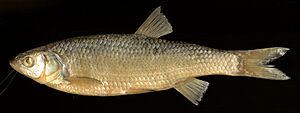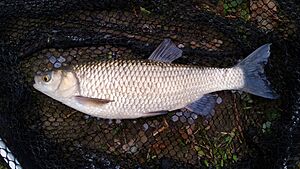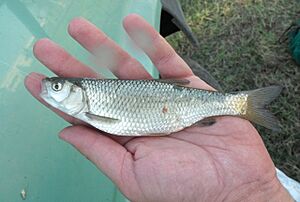Italian chub facts for kids
Quick facts for kids Italian chub |
|
|---|---|
 |
|
| Conservation status | |
| Scientific classification | |
| Synonyms | |
|
Leuciscus squalus Bonaparte, 1837 |
The Italian chub (scientific name: Squalius squalus) is a type of freshwater fish. It belongs to the carp family, called Cyprinidae. You can find this fish in rivers and streams across southeastern Europe. This includes countries like Italy, Switzerland, and parts of what used to be Yugoslavia. It is also known as the chubius chub or cavedano.
Contents
What Does the Italian Chub Look Like?
The Italian chub can grow quite large. Some have been found to be over 60 cm (24 in) long. They can also weigh more than 3 kg (6.6 lb). These fish can live for about fifteen years.
They have a long head and a big eye. The iris of their eye often has an orange tint. Their snout is pointed, and their mouth is long and slightly curved. The upper jaw sticks out a bit.
The body of the Italian chub is usually brownish or bronze. Their scales stay on well and do not fall off easily. Their pectoral, pelvic, and anal fins are greyish. This grey color helps tell them apart from a similar fish, Squalius cephalus. That fish has orange or reddish fins.
Where Does the Italian Chub Live?
The Italian chub is native to several European countries. These include Italy, Switzerland, and France (specifically in the Var river). You can also find them in rivers that flow into the Adriatic Sea. This covers parts of Slovenia, Croatia, and Bosnia and Herzegovina.
Recently, some Italian chubs were brought to North Carolina in the United States. This was done by North Carolina State University. The goal was to help increase the variety of fish in local rivers and streams.
These fish prefer rivers and streams that have "riffles" and "pools." Riffles are shallow, fast-flowing areas. Pools are deeper, slower-moving parts. They can also live in slow-flowing rivers and the shallower areas of lakes.
Life and Habits of the Italian Chub
Young Italian chubs like to stay in groups. You can find them in the shallow parts of streams, rivers, and lakes. They eat many different things, both plants and small animals.
As they get bigger, Italian chubs often become more solitary. The largest ones mainly eat other fish. Both male and female chubs are ready to reproduce when they are two years old. They usually breed between April and July.
A study showed that among young fish, there were more males. But as the fish got older, this changed. For fish over six years old, almost all of them were female.
Males gather in special breeding areas. These can be gravelly spots near lake edges, shallow riffles, or fast-flowing water. The females dig small dips in the ground. They lay their sticky eggs there, which the males then fertilize. Sometimes, Italian chubs can even breed with other fish species. These include Alburnus arborella and Alburnus albidus.
Is the Italian Chub in Danger?
The IUCN (International Union for Conservation of Nature) has looked at the Italian chub. They have listed this species as being of "Least Concern". This means the fish is not currently in danger. It lives in many places and there are lots of them. No major threats to their survival have been found.




